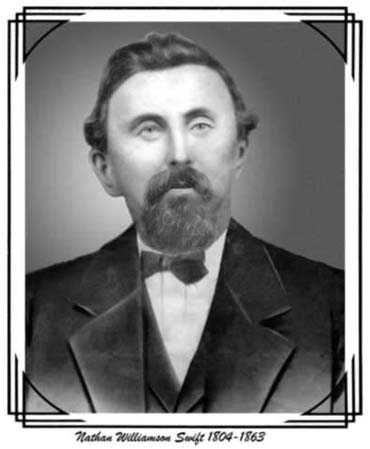




 |
 |
 |
 |
 |
A Legacy of HopeAs humans granted the gift of life, William and Amelia Swena Swift were the embodiment of their past. The sacrifices and the adventures of Amelia’s family, as it worked its way across the North American continent, are chronicled in its family history. William’s family history is also filled with stories of bold ventures, extensive migration, and hard daily work. To these families and to other families that created our common history, we owe a great deal of respect, admiration, and appreciation for the historical legacy that they have given to us. In fairness, we must also pay our respects to those that weren’t favored by the events of history. We live on the land and breathe the air that, at one time, belonged to the tribal cultures of North America—their loss was our gain. Even if our ancestors only occupied the abandoned lands of the Native American, as the Swifts did, we still need to respect the memory of the indigenous people and their way of life. As we read the history and accounts of our Western European pioneer families, let us not forget that a culture was supplanted and a way of life was ending as our common histories were beginning. |
 |
We can’t change history, but we can make history. We can start by exploring the inner nobility of those that lived before us and learn lessons from their actions. Also, we can live in peace and harmony with our world, in our given moment, and thus help manifest a just and human future. By blending the lessons from our ancestors with the integrity of our actions, we can leave a legacy of hope for succeeding generations. The Swifts produced generations of resourceful, hard-working people. Ralph S. Swift, a Swift Family researcher in England, has shown the early generations of Swifts to be positively imbedded in English history. William Swift brought our family line into this country to Goochland County, Virginia in the mid-seventeen hundreds. He fought in the Revolutionary War. His grandson, Nathan Williamson Swift was born in Caswell County, North Carolina in 1804. He was part of the generation of post-Revolutionary War citizens who helped build this country.When Nathan grew up, he migrated to Pike County, Kentucky where he married his first wife, Sarah Campbell. After the birth of their daughter,Elizabeth, the newly-weds moved to Morgan County, Illinois, where their son John Franklin Swift was born. Sarah died when she was twenty-four years old. From her humble beginnings, she probably never imagined that her son John would become the United States Ambassador to both China and Japan. Nathan married Mary Frances Pittman one year later and they had five children. Their first child was William Alexander Swift. Their fifth child, Araminta Swift died in infancy. It is possible that Mary Frances died while giving birth to Araminta.Sometime after the mid 1840s, Nathan migrated to California. He died in Saratoga, California on November 10, 1863 and was buried in Madronia Cemetery, Oak Street at 6th, in Saratoga. Gary Bacon |
|
Home Page Ancestry-Main Menu Contact Information |
Page 2 of 24. Use buttons in header to move from page to page. |